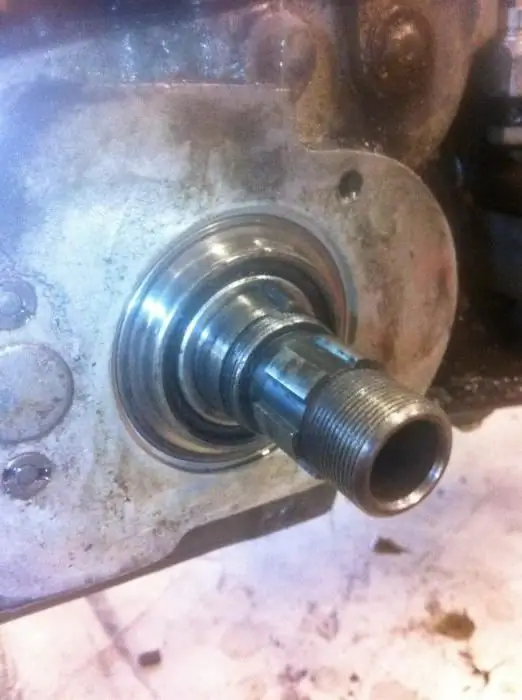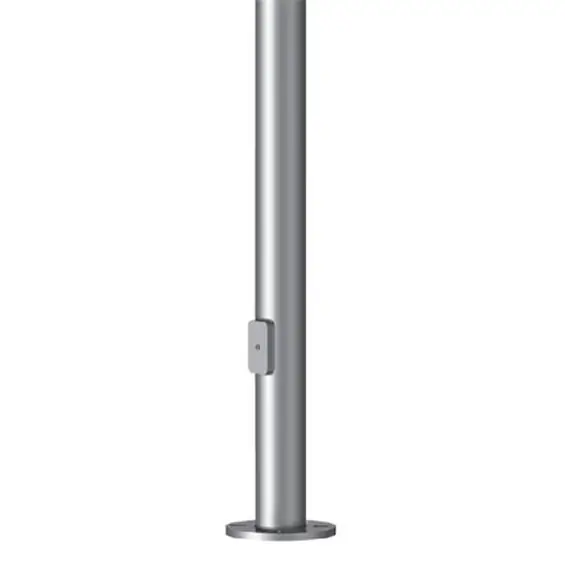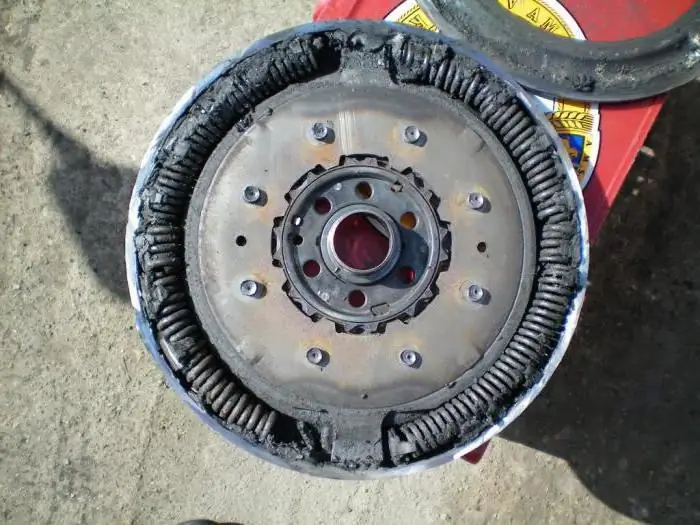2025 Author: Howard Calhoun | [email protected]. Last modified: 2025-01-24 13:10:31
Electrician is one of the most dangerous professions. In order to protect the personnel as much as possible, the enterprise provides them with overalls and footwear with protection against electric arcs. In addition, personal protective equipment (PPE) and professional power tools are also issued. Particular attention is paid to work under voltage and at height. For this, workers are provided with additional equipment with protective properties from an electric arc. These include safety harnesses, ladders, mats. One of the interesting devices that can be attributed to both personal protective equipment and tools is an insulating rod.
What does she do? This type of equipment allows you to work with electrical installations that are energized, but not more than 550 kV. Depending on the functionality, these tools are divided into two main types. There is an operational and measuring rod. We will consider their features later in our article.
Design features
The tool is a cutting that can be divided into three segments. This is a handle, insulating, as well as a working part. Suchelectrician's tool can be prefabricated or telescopic. The main thing is to provide the insulating element with a strong linkage.

Special metal fasteners can be used for this, but their total length should not exceed five percent of the length of the insulating part.
The working tip is made of metal or some dielectric material and, depending on the purpose, may have a different shape and functionality.
The insulating part is made of materials that do not conduct current. For example, it can be ebonite, bakelite, wood and others. According to technology, they are thoroughly boiled in linseed or hemp oil, dried. After that, the material is covered with an insulating varnish on top to protect it from moisture penetration.
The handle is most often made of the same material as the insulating part. Between these sections, a restrictive ring must be arranged, which, during operation, will prevent contact between the hand and the insulating section. The stopper must protrude at least ten millimeters and be at least three millimeters high.
The total length of the rod according to the state standard number 20494-2001 (“Insulating operational rods and portable grounding elements - technical specifications”) depends on the voltage of the electrical installation on which the work is performed.
In installations over 350 kV, tools are used to operate two electricians using a support device.
Main parameters
The weight of the equipment for the work of one person should not exceed eight kilograms. The force on one hand for measuring rods should not exceed 80N, for other types up to 160N. The length of the insulating part and the handle depends on the magnitude of the voltage, according to GOST 20494-2001.
Scope of elements
Working under voltage with a rod can be carried out in closed electrical installations, or outdoors, but in dry weather. Under no circumstances should this appliance be used in rainy, snowy or foggy weather.

In these weather conditions, there is a high risk of electric shock, which in some cases can lead to death.
With the help of this tool, operations are performed with disconnectors, changing fuses, installing arrester parts, checking insulation on power lines and substations, applying portable grounding, using it as a means of releasing an injured person from electric current, and performing measuring work.
The modifications and capabilities of each type should be considered in more detail.
Operational rod
There are four types according to the main functionality:
- SHO (operational isolation). Used for a large number of jobs due to the interchangeable head. Used on electrical installations with voltage up to 220 kV with direct or alternating current.
- SCO (rescue). With her helpit is possible to rescue a person from the zone of electric shock with a voltage of up to 110 kV. Urgent release measures increase the chances of resuscitating the victim.
- SHOW (universal insulating rod). It is used on electrical installations similar to SHO. At the same time, the maximum number of interchangeable working parts increases the functionality.
- ShZP (ground overlays). Also used in electrical installations with voltage up to 220 kV with direct or alternating current. This device allows you to approach areas with residual voltage or partial shutdown of the installation. Due to the work with the ShZP, the number of electrical injuries is significantly reduced.
Operational rod allows you to perform the necessary work under voltage. This eliminates the risk of electric shock. The main thing is to follow the rules for the operation, inspection and testing of PPE.
Ticks
Separate position is to provide insulating pliers. The element allows the replacement of fuses in electrical installations up to 1kV and above. They are also used to remove heads, guards in installations up to 350 kV inclusive.

It is allowed to replace this type of equipment with an operational universal rod, with an appropriate working head.
The size and weight of this equipment should ensure comfortable operation for one person. The insulating part and the handle must be made of materials with dielectric and antistatic properties.
Themselvespliers can be made of electrically insulating materials or metal. Oil and petrol resistant tubes must be put on metal sponges in order not to damage the surface of the cartridges during operation.
The length of the insulating clamp also depends on the magnitude of the voltage:
- At voltage from 1-10 kV, the length of the insulating section is 450 mm, the handles are 150 mm.
- For voltages from 10-35 kV, the length of the insulating section is 750 mm, the handles are 200 mm.
Measuring
Using this professional power tool, it became possible to determine surges, voltage drops in sections of an electrical installation that is in normal operating mode. There are two methods: by measuring the temperature of the contacts or by directly measuring voltage surges.
The measuring head is a spark gap adjusted in the laboratory. The minimum allowable value is set. The working head through a parallel connection to the tested area, using indicators, shows the presence or absence of voltage. It is important that the electrical installation is in normal operating mode at the time of inspection.
There are three main types:
- SHIU. This device provides the ability to change the distance between the electrodes, which allows you to most accurately obtain measurement data.
- SHI. In such devices, a pointer microammeter with an additional resistance of up to 160 megaohms is installed. Depending on the measurement method, a set of probes with conductors changes in the working area,which are connected to clamps. The probes are applied to the controlled insulator, a parallel connection takes place. The arrow of the microammeter shows the result of measurements.
The SHI device is also used for the second method. Probes are installed to measure the temperature on the contacts.
Electrical clamps. It is a current transformer with a detachable magnetic core. For the primary winding, a conductor with a measured current is used, and the secondary is closed to a measuring device, either pointer or digital
Operating conditions
The insulating rod should be used in an outdoor environment with a temperature regime of minus 45°C to plus 40°C with a relative humidity of 98% at 25°C.
No utensils allowed:
- Not having the appropriate certificates, and not having passed the test, respectively, do not meet safety standards.
- Faulty. Such devices must be repaired. Then the tests were carried out. And only according to the data received, a decision is made on the further use or disposal of the device.
- With high humidity. In wet weather.
- With the use of supports (ladders) for measuring work.
Employees with appropriate permits are allowed to work on electrical installations. Each employee must be equipped with a full set of PPE, including dielectric gloves, dielectric boots, overalls with arc protection, goggles and a respirator. All this will help to protect the employee as much as possible fromelectrical injury.
Before operation, the insulating rod must be visually inspected.

In the event of a malfunction, it should be replaced by another instance.
Mechanical testing is not carried out during operation. Scheduled and unscheduled can be carried out when the device falls, flaws are found. The device is preliminarily repaired.
Testing
Because work on an electrical installation is classified as dangerous, electrician's tools are subject to careful inspection and control. Moreover, depending on the equipment, tests are carried out at the manufacturing plant. According to GOST 20494-2001 they can be:
- Acceptance. Spend for each item.
- Periodic. Every bar must be exposed.
- Typical. Selectively test three samples of the same type. All kinds of tests will need to be done.
All testing activities are carried out by the manufacturer with the help of specially trained people who have a certain level of clearance and have been trained and certified.

These operations must be performed in a timely manner, the life and he alth safety of an electrician depends on it.
Test List:
- Visual control. Checking the completeness, labeling, packaging. The presence of the required documentation and compliance with the required security is checked.
- Checking against factory drawings. Produced withusing measuring tools, there must be a complete match of the parameters.
- Checking electrical insulation for strength. They are produced by alternating current of industrial frequency by a single application for no more than five minutes. In this case, the voltage increase to 1/3 of the value can be arbitrary. Further increase should be smooth. The working and insulating parts of the rod are checked. If it is not possible to test with a full measuring section, then this part of the rod is checked by segments. If breakdowns, local heating from dielectric losses, surface discharges are not detected, then it is considered that the product has successfully passed the test.
- Tear test. One end of the rod is fixed, the other is subjected to a permissible load with the help of a load or a winch. Test passed with no visible damage.
- Bending test. The product is fixed horizontally at two points at the restrictive ring and the end of the handles. Sample rod passed the test with no visible damage.
- Checking the greatest effort per hand. A horizontally fixed bar is attached using two points - the front (50 mm from the restrictive ring) and the rear (50 mm from the end of the handle) supports. The measurement is made on the front support and the indicator should not exceed 160N. Insulating rod up to 1000V is not subjected to this type of test.
If the result is negative, repeat the procedure with more samples. If the data is repeated, the entire type of product is withdrawn andthe release of a new batch is prohibited until the causes of negative indicators are clarified and eliminated. In such situations, the test stamp is crossed out with a red line.
All tests are carried out in accordance with current regulations.

For operational devices, tests are carried out every two years, for measuring devices - once a year.
Choice of equipment
In order for an employee to be provided with the right PPE and tools, the relevant state standards and regulations should be studied. This will help you choose the right kit for each type of work.
The price set for the insulating rods will play an important role for the consumer in the choice of fixture. On average, it is 500 rubles. But do not chase cheap devices. You should carefully study the warranty obligations of the manufacturer and the package of documents provided by them. All items must be pre-sale tested and stamped.
Result
In conclusion, I would like to note that the modern world cannot imagine itself without electricity. This means that you cannot do without measuring rods.

It's hard to imagine what would happen if there was a worldwide power outage. There will probably be chaos and panic. Therefore, people who service electrical installations should be treated with great respect and respect, and the relevant authorities should provide them with all the necessary personal protective equipment as much as possible.
So, we found out what such a technical tool as an insulating rod is.
Recommended:
PVC Insulating Tape Specifications

PVC insulating tape has found wide application in a variety of areas - from domestic work to oil and gas pipeline insulation
Connections: purpose, types of connections. Examples, advantages, disadvantages of types of compounds

Machines and machine tools, equipment and household appliances - all these mechanisms have many details in their design. Their high-quality connection is a guarantee of reliability and safety during work. What types of connections are there? Let's take a closer look at their characteristics, advantages and disadvantages
Steel support: types, types, characteristics, purpose, installation rules, operation features and applications

Steel poles today are most often used as lighting poles. With their help, they equip the lighting of roads, streets, courtyards of residential buildings, etc. In addition, such structures are often used as supports for power lines
Clutch flywheel: description, types, purpose and principle of operation

Everyone knows that the main task of an engine is to convert energy into torque. Its transmission is carried out through a special flywheel of the clutch disc. This node is available in any car. How is it arranged and functioning? All this and more - further in our article
Milling machining center: types, description and purpose

Today, a milling machining center is a multi-operation machine with numerical software. The main advantage is the ability to carry out complex machining of three-dimensional parts. For this purpose, the center is equipped with various processing devices

